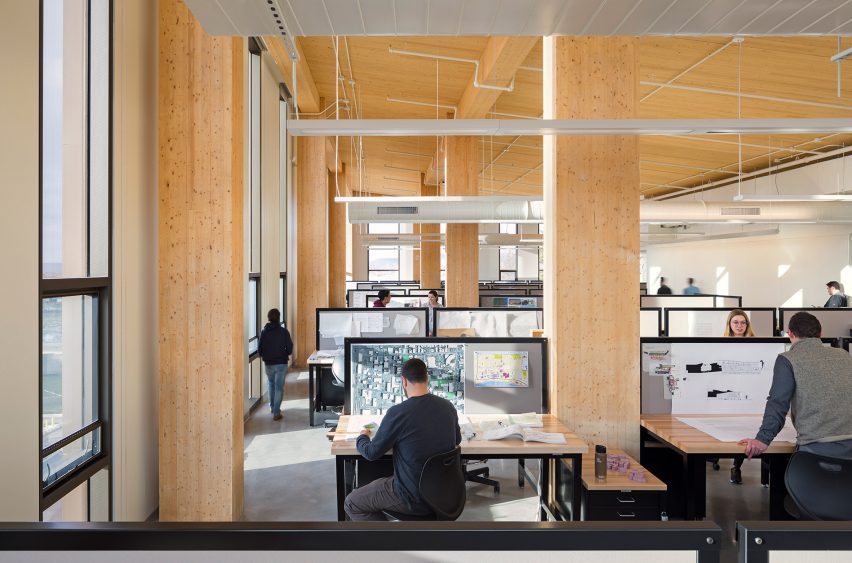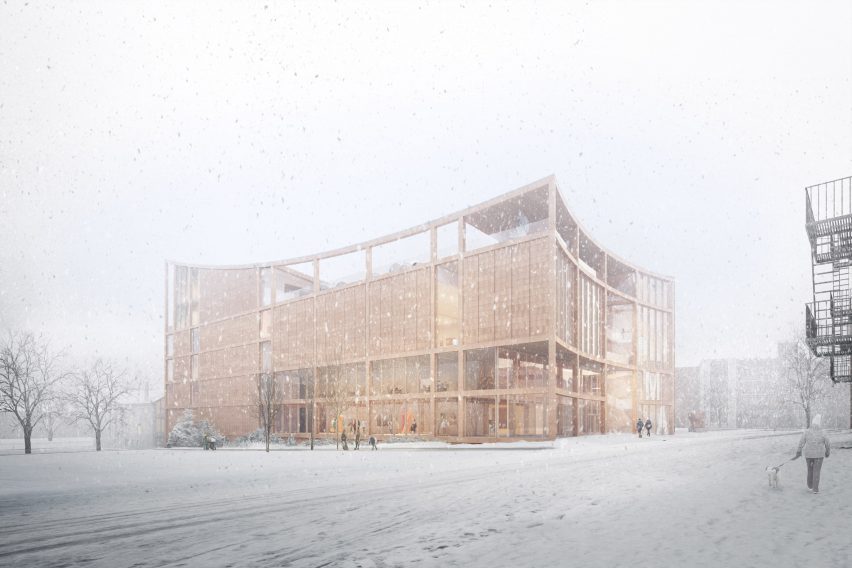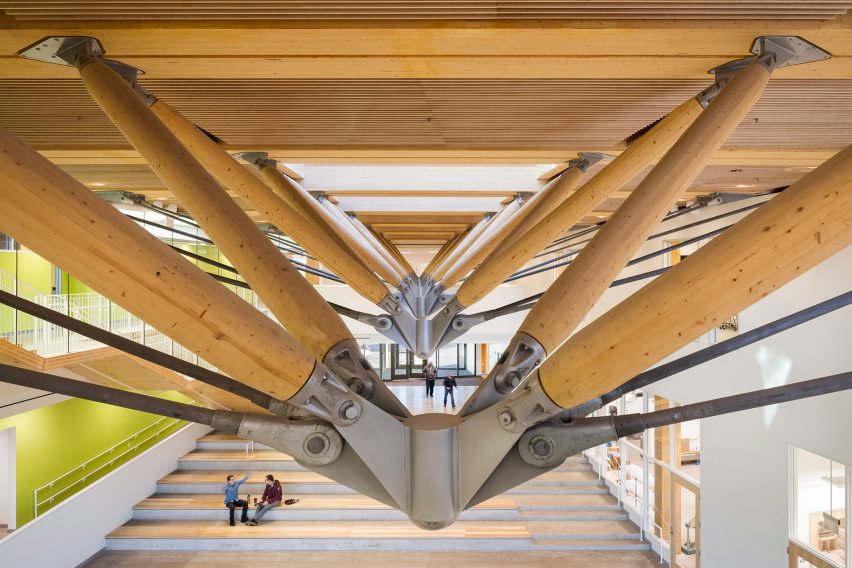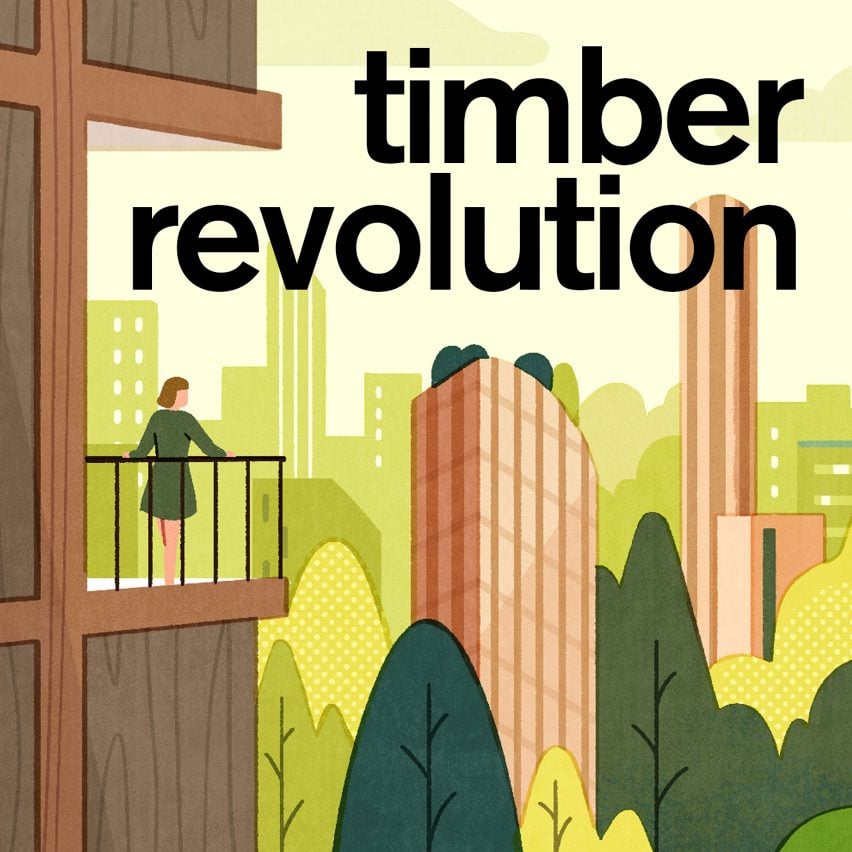
"Mass-timber buildings can have very high carbon emissions" says Amy Leedham
Mass timber's reputation as the go-to low-carbon construction material is a problematic oversimplification that is leading to greenwashing, says carbon expert Amy Leedham in this Timber Revolution interview.
"We're seeing a little bit of oversimplification and glorification of mass timber," said Leedham, who is carbon lead at engineering consultancy Atelier Ten.
"The main thing that you see in the media, and one of the reasons it's becoming such a popular building material, is that it can have a significantly lower embodied carbon than steel or concrete," she told Dezeen. "I say 'can' because it's not always the case."

Mass timber is a term for engineered-wood products – strong structural components that typically consist of layers of wood bonded together.
It is increasing in popularity in the construction industry due to wood's ability to sequester carbon, which means timber generally has a lower embodied carbon when compared to materials such as concrete and steel.
However, according to Leedham, this has caused mass timber to become synonymous with carbon neutrality, leading to the fallacy that all "mass-timber buildings are carbon neutral" due to the stored carbon offsetting the emissions expended by them.
"Critical factors that need to be considered"
"Mass timber construction can definitely be an important pathway toward carbon neutrality, but there are other critical factors that need to be considered," she told Dezeen.
"If it's not done well, mass timber buildings can have very high carbon emissions, whereas concrete buildings can have quite low carbon emissions," she said.
"We've worked on concrete projects with certain concrete suppliers where they're really focusing on reducing emissions associated with the concrete mixes and those can have quite low carbon emissions. There's no black and white, it's all hues of grey."

Carbon neutrality is achieved when no additional carbon dioxide is added to the atmosphere in the creation and operation of an entity, such as a building. This can either involve eliminating emissions in the first place, negating emissions through offsetting, or a combination of both.
Assuming that using mass timber achieves this through its sequestered carbon alone can overlook several factors, such as the carbon footprint of other materials used to construct wooden buildings, including the interior finishes.
"Mass timber buildings have a lot of other material in them, especially in places where the code is challenging, especially for taller mass timber," Leedham said.
Additionally, the carbon footprint of mass timber can also be impacted by how and from where the wood was sourced and transported, and what happens to it at the end of its useful life.
If the wood used in a building's construction ends up in a landfill, it is likely to be incinerated or left to decompose, with its sequestered carbon released back into the atmosphere – cancelling out the carbon benefits.
"We can only control up to the point that the building is built"
"Forestry practices are super important to the overall carbon impact of mass timber, as well as end-of-life treatment," explained Leedham.
"As designers and engineers, we can only control up to the point that the building is built. We can design in certain aspects so that it can be treated well at the end of its life in 100 years, but we don't know what's going to happen."
The overlooking of these "critical factors" recently prompted Leedham to write a series of myth-busting essays on engineered wood, co-authored and published with US studio Lever Architecture.
The essays shine a light on the main misconceptions about mass timber that are circulating in the industry, in an effort to expose the truth behind them and promote the responsible use of the material in architecture.
"Mass timber is super important to the future of low-carbon construction," she said.
"But it's also really important that it's done right. If it's done incorrectly, then it's just another form of greenwashing."
Alongside the misunderstandings about mass timber and carbon neutrality, the essays also debunk beliefs that "all wood is good wood", that it is always more sustainable than concrete, and that mass-timber buildings actually absorb carbon.
Co-author Jonathan Heppner, who is a principal at Lever Architecture, said the authors have heard these myths in discussions about their own projects, but also at industry events.
"These myths emerge very frequently"
"Variations on these myths emerge very frequently where architectural and engineering professionals meet to discuss construction and procurement with project owners, builders, manufacturers and trade representatives," Heppner told Dezeen.
"These myths surface at symposiums, trade shows, conferences, lectures, or in conference rooms where decisions around the incorporation and advancement of mass-timber systems are being discussed," he continued.
Both he and Leedham hope their publication will contribute to "more nuanced narratives from the mass timber industry" and advocate "healthy innovation" in this space.
In the essays, the authors outline how the industry can combat these myths – such as by encouraging architects to make conscientious sourcing decisions, which can, in turn, incentivise the timber industry to manage forests sustainably, and by improving understanding of carbon neutrality and how it can be achieved.

Leedham told Dezeen that these solutions could also all be supported by the roll-out of worldwide carbon taxes for construction projects, which would require payments for the greenhouse gas emissions emitted by building components.
Not only would this lead to the more responsible use of mass timber, she said, but it would also encourage more sustainable practices when it comes to using materials such as concrete and steel.
"Carbon taxes would definitely speed up the adoption of any type of more sustainable construction practice," said Leedham.
"If you had to pay for all the carbon emissions before you got your building permit, I think that would encourage the use of mass timber, it would encourage sustainable forestry practices, and it would actually encourage both the concrete and steel industry to reduce their emissions."
Mass timber will not "dominate the industry"
This last point is particularly important as she believes that concrete and steel will remain vital materials in the future of architecture.
"The reality is that we need everything. Mass timber is one of a kit of parts," said Leedham.
"I don't think mass timber is going to ever dominate the industry, just because of the sheer volume of construction that's happening, and I don't think it wants to."
"We absolutely need steel and concrete industries to also focus on reducing their emissions because we're going to need all three primary structural materials," she added.
This echoes the views of construction material expert Benjamin Kromoser, who told Dezeen in an interview that mass timber will not become a mainstream building material because it uses too much wood
"Wood is a limited resource," he said. "It always has to be a balance between what we take from the forest to use for building construction and how much grows again."

Timber Revolution
This article is part of Dezeen's Timber Revolution series, which explores the potential of mass timber and asks whether going back to wood as our primary construction material can lead the world to a more sustainable future.